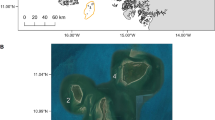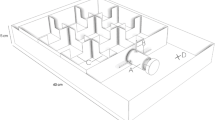Abstract
Thirteen adult Orconectes limosus males (carapace length 32.5 ± 2.48 mm; weight 10.8 ± 2.63 g) were radio-tagged and tracked during and after the spring mating period, April–June 2008. Average distances moved per day were higher in the mating period (14.9 ± 21.4 m) due to mate searching activity. During the mating period, movement did not correlate with water temperature, and crayfish were active during daylight hours. They moved rapidly upstream and downstream, a maximum 118 and 95 m per day, respectively. When water temperature increased over 10°C, this initiated the end of mating and the start of spawning, and the spring migration abruptly ceased. An influence of water temperature on movements was observed during the non-reproductive period. Orconectes limosus was highly mobile in small watercourses, signifying a threat of penetration into native crayfish habitats, and potentially enabling the transmission of crayfish plague. This threat was increased during the mating period due to increased activity.

Similar content being viewed by others
References
Aquiloni L, Ilhéu M, Gherardi F (2005) Habitat use and dispersal of the invasive crayfish Procambarus clarkii in ephemeral water bodies of Portugal. Mar Freshw Behav Physiol 38:225–236
Barbaresi S, Santini G, Tricarico E, Gherardi F (2004) Ranging behaviour of the invasive crayfish, Procambarus clarkii (Girard). J Nat Hist 38:2821–2832
Bohl E (1999) Motion of individual noble crayfish Astacus astacus in different biological situations: in situ studies using radio telemetry. Freshw crayfish 12:677–687
Bowman J, Kidd A, Gorman R, Schulte-Hostedde A (2007) Assessing the potential for impacts by feral mink on wild mink in Canada. Biol Conserv 139:12–18
Bubb DH, Lucas MC, Thom TJ (2002) Winter movements and activity of signal crayfish Pacifastacus leniusculus in an upland river, determined by radio telemetry. Hydrobiologia 483:111–119
Bubb DH, Lucas MC, Thom TJ (2004) Movement and dispersal of the invasive signal crayfish Pacifastacus leniusculus in upland rivers. Freshw Biol 49:357–368
Bubb DH, Thom TJ, Lucas MC (2006) Movement, dispersal and refuge use of co-occuring introduced and native crayfish. Freshw Biol 51:1359–1368
Buřič M, Kozák P, Vích P (2008) Evaluation of different marking methods for spiny-cheek crayfish (Orconectes limosus). Knowl Manage Aquatic Ecosyst 389:1–8
Buřič M, Kozák P, Kouba A (2009) Movement patterns and ranging behavior of the invasive spiny-cheek crayfish in a small reservoir tributary. Fundam Appl Limnol 174:329–337
Capelli GM, Magnuson JJ (1983) Morphoedaphic and biogeographic analysis of crayfish distribution in northern Wisconsin. J Crustacean Biol 3:548–564
Füreder L, Edsman L, Holdich DM, Kozák P, Machino Y, Pöckl M, Renai B, Reynolds JD, Schulz H, Schulz R, Sint D, Taugbol T, Trouilhé MC (2006) Indigenous crayfish habitat and threats. In: Souty-Grosset C, Holdich DM, Noël P, Reynolds JD, Haffner P (eds) Atlas of crayfish in Europe. Publications Scientifiques du MNHN, Paris, pp 25–48
Gherardi F (2002) Behaviour. In: Holdich DM (ed) Biology of freshwater crayfish. Blackwell, London, pp 258–290
Gherardi F, Barbaresi S (2000) Invasive crayfish: activity patterns of Procambarus clarkii in the rice fields of the lower Guadalquivir (Spain). Arch für Hydrobiol 150:153–168
Gherardi F, Barbaresi S, Salvi G (2000) Spatial and temporal patterns in the movement of Procambarus clarkii, an invasive crayfish. Aquat Sci 62:179–193
Gherardi F, Tricarico E, Ilhéu M (2002) Movement patterns of an invasive crayfish, Procambarus clarkii, in temporary stream of southern Portugal. Ethol Ecol Evol 14:183–197
Green J, Green R (1981) The otter (Lutra lutra L.) in Western France. Mamm Rev 11:181–187
Hamr P (2002) Orconectes. In: Holdich DM (ed) Biology of freshwater crayfish. Blackwell, London, pp 585–608
Holdich DM, Black J (2007) The spiny-cheek crayfish, Orconectes limosus (Rafinesque, 1817) [Crustacea: Decapoda: Cambaridae], digs into the UK. Aquat invasions 2:1–16
Holdich DM, Haffner P, Noël P, Carral J, Füreder L, Gherardi F, Machino Y, Madec J, Pöckl M, Śmietana P, Taugbol T, Vigneux E (2006) Species files. In: Souty-Grosset C, Holdich DM, Noël P, Reynolds JD, Haffner P (eds) Atlas of crayfish in Europe. Publications Scientifiques du MNHN, Paris, pp 49–130
Kozák P, Buřič M, Policar T, Hamáčková J, Lepičová A (2007) The effect of inter- and intra-specific competition on survival and growth rate of native juvenile noble crayfish Astacus astacus and alien spiny-cheek crayfish Orconectes limosus. Hydrobiologia 590:85–94
Kozubíková E, Petrusek A, Ďuriš Z, Martín MP, Diéguez-Uribeondo J, Oidtmann B (2008) The old menace is back: recent crayfish plague outbreaks in the Czech Republic. Aquaculture 274:208–217
Lozan JL (2000) On the threat to the European crayfish: a contribution with the study of the activity behaviour of four crayfish species (Decapoda: Astacidae). Limnologica 30:156–166
McAlpine D, Hogans WE, Fletcher TJ (1991) Orconectes limosus (Crustacea, Cambaridae) an addition to the crayfish fauna of New Brunswick. Can Field Nat 105:386–387
Musil M, Buřič M, Policar T, Kouba A, Kozák P (2009) Comparison of day and night activity between noble (Astacus astacus) and spiny-cheek crayfish (Orconectes limosus). Freshw Crayfish 17 (in press)
Petrusek A, Filipová L, Ďuriš Z, Horká I, Kozák P, Policar T, Štambergová M, Kučera Z (2006) Distribution of the invasive spiny-cheek crayfish (Orconectes limosus) in the Czech Republic: past and present. Bull Français de la Pêche et de la Pisciculture 380–381:903–917
Pöckl M, Holdich DM, Pennerstorfer J (2006) Identifying native and alien crayfish species in Europe. European Project CRAYNET
Robinson CA, Thom TJ, Lucas MC (2000) Ranging behaviour of a large freshwater invertebrate, the white-clawed crayfish Austropotamobius pallipes. Freshw Biol 44:509–521
Schütze S, Stein H, Born O (1999) Radio telemetry observations on migration and activity patterns of restocked noble crayfish Astacus astacus (L.) in the small river Sempt, North-East of Munich, Germany. Freshw Crayfish 12:688–695
Stucki TP (2002) Differences in live history of native and introduced crayfish species in Switzerland. Freshw Crayfish 13:463–476
Van Den Brink FWB, Van Der Velde G, Geelen JFM (1988) Life history parameters and temperature-related activity of an American crayfish, Orconectes limosus (Rafineque, 1817) (Crustacea, Decapoda), in the area of the major rivers in The Netherlands. Arch für Hydrobiol 114:275–289
Acknowledgments
This investigation was supported financially by the Czech Ministry of Education (project USB RIFCH No. MSM6007665809), and the Czech Science Foundation (projects GAAV IAA601870701). We also deeply appreciate the assistance of the Lucidus Consultancy for correcting this manuscript.
Author information
Authors and Affiliations
Corresponding author
Rights and permissions
About this article
Cite this article
Buřič, M., Kouba, A. & Kozák, P. Spring mating period in Orconectes limosus: the reason for movement. Aquat. Sci. 71, 473–477 (2009). https://doi.org/10.1007/s00027-009-0102-6
Received:
Accepted:
Published:
Issue Date:
DOI: https://doi.org/10.1007/s00027-009-0102-6




